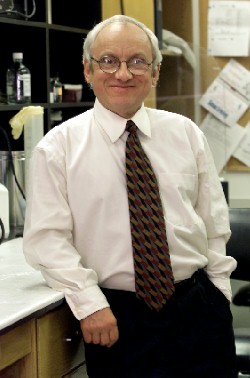
Dr. Jacek Hawiger is directing Vanderbilt's new Cellular and Molecular Microbiology training program.
New program links microbiology, cell biology training
A new NIH training grant will increase research efforts at the crossroads of microbiology and cell biology.
Faculty from Vanderbilt University and Meharry Medical College will participate in the recently established Cellular and Molecular Microbiology (CMM) training program.
"The field of cellular microbiology is a coalescence of two fields: molecular microbiology and cell biology," said program director Dr. Jacek Hawiger, Oswald T. Avery Professor and Chair of Microbiology and Immunology. "A paper in [the journal] Science three years ago introduced this new field, which calls for the vigorous application of modern advances in molecular cell biology to the study of the pathogen-host interaction.
"I think our training program is one of the first in the country to focus on this very important new field."
In addition to applying advanced cell biological techniques to microbiology, the new field encourages the use of pathogens to tackle questions in cell biology. Pathogens, such as viruses and bacteria, interact with cellular proteins and usually disrupt normal cellular functions, making them good tools for studying those normal functions.
For example, the bacteria Yersinia injects a protein into cells that disrupts the cellular cytoskeleton — the internal scaffold that gives the cell shape and organizes its functions. Yersinia is therefore a useful tool for studying roles of the cytoskeleton.
The new program will emphasize research that probes pathogen-host interactions, beginning at the point of microbial adhesion to cellular receptors and including the variety of interactions that occur inside the cell, such as how pathogens alter signaling pathways and gene regulation.
Ultimately, the program will focus on interpreting the molecular 'conversations' between some of the 10,000 proteins present in an average cell and the proteins produced by disease-causing germs. Genetic blueprints for about 60 different germs will soon be available.
A steering committee will oversee the program. The committee includes Hawiger, Ann Richmond, Ph.D., professor of Cell Biology and Medicine and program co-director, and Neil Green, Ph.D., associate professor of Microbiology and Immunology and program associate director.
Representatives from other participating departments are: Linda Sealy, Ph.D., associate professor of Molecular Physiology and Biophysics and of Cell Biology, Wallace M. LeStourgeon, Ph.D., professor of Molecular Biology, Virginia L. Shepherd, Ph.D., professor of Pathology and Medicine, and Robert G. Holt, Ph.D., associate professor of Microbiology at Meharry Medical College.
By integrating faculty members from five Vanderbilt departments and from Meharry, the program will offer a wide variety of research opportunities for trainees.
"There are complementary strengths between pursuits at Vanderbilt and those in the department of Microbiology at Meharry," Hawiger said.
"For example, Meharry has strength in parasitology research which is lacking at Vanderbilt.
"In creating this program, we are capitalizing on the very high level of intellectual and technological resources represented by the participating faculty at Vanderbilt and Meharry and also on advances in cell biology and microbiology."
To draw trainees into the field of cellular microbiology, the program will offer a new interdepartmental and interinstitutional graduate course called "Cellular Microbiology of Pathogen-Host Interaction."
This new course will emphasize emerging research opportunities in the area of functional genomics of mammalian and microbial cells and will challenge students to think about possible designs for new vaccines and anti-microbial drugs.
A unique feature of the CMM program is an innovative, dual mentoring system in which each predoctoral student will have two faculty advisors from different participating departments (for example from Microbiology and Cell Biology).
Trainees will also engage in a joint journal club focused on cellular microbiology.
"I am very pleased and excited about our new training program in Cellular and Molecular Microbiology," Richmond said. "We have a wonderful training faculty which includes both Meharry and Vanderbilt faculty. And because we plan to interact with students throughout the training period, not just during the time they are on the training grant, they should have time to develop a collegial relationship with the faculty."
The new CMM training program reflects the spirit of the alliance agreement between Vanderbilt and Meharry. A bi-institutional oversight committee will meet each year to monitor the program's overall mission, recruiting efforts, training outcome, and impact on both institutions. Faculty serving on the oversight committee are: George C. Hill, Ph.D., vice-president for Sponsored Research, and Maria F. Lima, Ph.D., dean of Graduate Studies and Research, both from Meharry, and Roger Chalkley, D.Phil., senior associate dean for Biomedical Research Education and Training, Brigid L. M. Hogan, Ph.D., Hortense B. Ingram Professor of Cell Biology and Howard Hughes Medical Institute investigator, and James V. Staros, Ph.D., professor of Molecular Biology and Biochemistry and chair of the department of Biological Sciences, from Vanderbilt.













